 |
 |





 |
 |
 |
 |
 |
 |
Agencies conduct security, education, enforcement inspection at Mn/ROAD
|
 |
 |
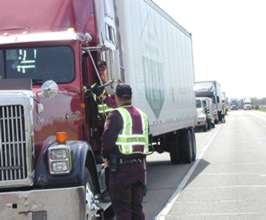 |
A State Patrol inspector
looks over the credentials of a commercial vehicle operator at the Mn/ROAD
facility in Albertville on May 22. The inspection was part of a larger
effort to ensure that operators who transport hazardous and other cargo
are safe, law-abiding and knowledgeable. Photo by Ted Coulianos
|
For a 48-hour period beginning at 8 a.m. on May 22, commercial vehicles traveling
westbound on I-94 were directed to the Minnesota Road Research Facility in Albertville,
where law enforcement agencies used new and existing technologies to evaluate
commercial driver and vehicle safety.
The saturation effort, coordinated by the Minnesota State Patrol, was the largest
commercial vehicle inspection effort to date.
Different types of inspections are conducted as part of saturations. Vehicle
inspections determine whether regulations governing weight, equipment, load
securement and hazardous materials handling are met. Driver inspections cover
use of seat belts, proper documentation, valid driverís license, drug and alcohol-related
impairment, fatigue and knowledge of cargo.
"We want to ensure that the operators who transport hazardous materials
and other cargo on our highways are safe, law-abiding and knowledgeable,"
said Capt. Ken Urquhart, Minnesota State Patrol.
Dennis Creen, a safety inspector with Motor Carrier Services, reports that
the system works well. As part of a license check during the saturation, one
driverís commercial driverís license raised Creenís suspicions. The license
was passed through a portable ion scanner that detects the presence of illegal
chemicals. The scanner indicated a cocaine residue on the license. The truck
cab was then scanned, indicating a presence of additional drugs. The State Patrol
arrested the driver for operating under the influence of a controlled substance
and his vehicle was towed from the inspection site.
"This is not the typical driver on the highway," said Creen. "Most
commercial drivers are very professional and concerned with security and safety.
A small minority disregard roadway safety."
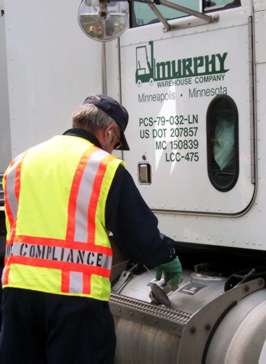 |
|
A commercial vehicle
inspector checks a fuel tank. In addition to ensuring safety, the overall
initiative will provide data for Mn/ROADís outdoor pavement laboratory.
Photo by Ben Worel
|
The safety initiative also will provide data for Mn/ROADís outdoor pavement
laboratory.
"Mn/DOT is pleased to be partnering with the State Patrol by providing
the location for this study to take place," said Gerald Rohrbach, Materials
and Road Research director. "Increasing safety on our roadways is crucial
to Mn/DOTís Moving Minnesota efforts."
Agencies that participated in the saturation included Mn/DOT, the Minnesota
State Patrol; Minnesota Department of Revenue; Wright and Hennepin county sheriffís
offices; Minneapolis, St. Paul, Rochester, Edina Elk River and Plymouth police
departments; Minnesota National Guard; Federal Motor Carrier Safety Administration;
Internal Revenue Service, and Immigration and Naturalization Service.
Specific data indicating number of vehicles inspected, violations detected
and out-of-service orders issued were not available at press time.
By Mary Meinert
|
back

|
 |
SMT makes no changes to Bridges and Structures, Materials and Road Research offices
|
 |
 |
The Senior Management Team May 21 decided no changes would be made in the Office
of Bridges and Structures and the Office of Materials and Road Research as part
of the departmentís Shaping Our Future-Phase II effort.
Phase I of Shaping Our Future focused on the change management process, which
evaluated whether or not to distribute office functions to the districts and
Metro Division. Phase II is evaluating the level of service needed to meet the
priorities of each office.
The Office of Bridges and Structures was among the first to undergo Phase II
evaluation. It was found that the office was meeting demands in all areas with
a need to focus more on bridge standards and research policies. SMT directed
the office to use consulting firms to supplement staff in order to meet office
priorities.
SMT also decided to continue the current level of effort in the Office of Materials
and Road Research. As part of the office, Mn/ROAD will continue to focus on
cooperative efforts with other agencies while maintaining state and national
leadership.
See Mn/DOTís ihub for more information about the Shaping
Our Future effort.
By Daneeka Marshall-Oquendo
|
back

|
 |
Legislative audit on Hwy 55/Hwy 62 interchange finds Mn/DOT contract legal, reasonable
|
 |
 |
An audit conducted by the Legislative Auditor and released May 28 found that
Mn/DOT adhered to all Minnesota statutes in addressing the safety concern at
the interchange of Hwy 55 and Hwy 62 in south Minneapolis.
"The audit confirms that hiring Minnesota Transit Constructors to prepare this
interchange for winter was the right choice," Commissioner Elwyn Tinklenberg
said.
Last fall, when authorizing Minnesota Transit Constructors to begin work before
a contract was approved, Mn/DOT did not follow Department of Administration
policy. However, Tinklenberg noted, "While the policies of another state agency
were not strictly followed, it is important to note that state law was adhered
to.
"We had just six weeks to prepare the interchange for winter. Not acting quickly
could have exposed drivers to dangerous conditions and the state to considerable
legal risks and potential damages, estimated to approach $750,000, that could
be caused by delaying light rail transit construction," he added.
For more information, read the Mn/DOT
news release or click here to view what
the news media had to say, including:
|
back

|
 |
State bridges better able to withstand forces that caused Oklahoma bridge collapse
|
 |
 |
Bridges on Minnesotaís trunk highway system are less likely to fail if struck
by a barge as occurred recently in Oklahoma because they are designed to withstand
the force created by ice loading pressure during the winter.
The collapse occurred May 26 on an I-40 bridge over the Arkansas River when
a barge struck a pier on the 35-year-old bridge, causing a 600-feet long section
to fall into the river. Officials report the mishap caused 13 deaths.
Dan Dorgan, state bridge engineer, said state design standards give Minnesotaís
bridges an extra margin of safety.
"For the past 10 years, we have designed bridge piers to withstand impacts
from barges in accordance with revised codes nationally," he said.
If a barge does strike a bridge, he said, a team of inspectors checks for damage.
If there is damage or potential damage, the bridge is immediately closed to
protect the public and to give the inspectors extra time to conduct a more thorough
examination of the structure.
According to Federal Highway Administration standards, 86 percent of Minnesotaís
bridges are rated in good condition compared with 72 percent nationwide.
Mn/DOT inspects bridges yearly except for those meeting certain criteria, which
then are checked every two years.
Dorgan adds, however, that the stateís bridges are aging rapidly and experiencing
significant increases in traffic and wear that shorten a bridge's service life.
"Without an increase in current funding," he said, "we may not
be able to maintain the condition of our bridges."
By Craig Wilkins
|
back

|
 |
Rochester District announces new management appointments
|
 |
 |
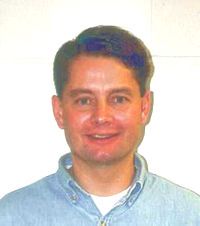 |
|
Steve Lund, Rochester
assistant district engineer for contract administration
|
Rochester/District 6 revamped its management structure to increase its responsiveness
to current and future challenges.
The district announced that Steve Lund, the Rochester area maintenance engineer,
will serve as assistant district engineer for contract administration. His appointment
becomes effective June 19.
In his new position, Lund will manage the districtís construction, traffic,
materials and survey offices.
In addition, Tony Hames will resume his former responsibilities as ADE for
program delivery, managing the design, planning and right-of-way functions.
Until Lundís appointment, Hames also managed the areas now assigned to Lund.
In the maintenance area, Jeffrey Vlaminck, currently the Willmar regional engineer
with Willmar/District 8, will become area maintenance engineer at Owatonna.
Vlaminckís appointment begins June 19. Bernie Arsenau, currently the acting
AME at Owatonna, will assume responsibilities as the AME at Rochester also on
June 19.
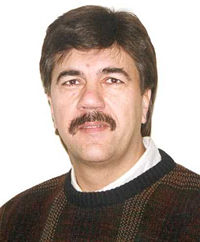 |
|
Jeffrey Vlaminck, Owatonna
area maintenance engineer
|
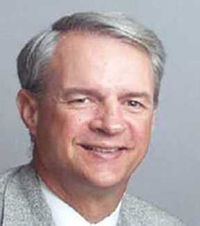 |
|
Tony Hames, Rochester
assistant district engineer for program delivery
|
|
back

|
 |
New research could improve environment, driving safety, home buying
|
 |
 |
Safer roads, more affordable homes in some locations, faster right-of-way acquisition
and less erosion of streambanks are goals of several research projects recently
announced by Mn/DOTís Office of Research Services and the University of Minnesotaís
Center for Transportation Studies.
Some projects proposed for 2003 have been approved, but others are still in
the evaluation stage, according to Adeel Lari, Research Services director.
"This summer, Research Services will be holding focus groups with Mn/DOT
leadership to develop a research agenda on policy issues for 2003," he
said.
Approved studies include:
Safe use of ATIS with cell phones
This set of studies will look at driversí use of Advanced Traveler Information
Systems with cell phones. Driving performance and safety indices will be studied
as they relate to the complexity of the menu structure and information content
of the 511 traveler information service. The study will see how the 511 service
affects driving safety and driversí ability to respond to driving conditions.
Researchers will develop recommendations about access methods for using cell
phones.
Guidelines for bioengineering in the Upper Midwest
This study will look at the effectiveness of methods currently used to stabilize
streambanks near bridges and roadways.
It will propose research on soil bioengineering techniques to stabilize streambanks
near bridges and roadways and suggest areas for further research.
The study will also evaluate potential sites for an outdoor bioengineering
research facility. The design aids that are currently available donít apply
well to Minnesota because they use vegetation that canít thrive in Minnesotaís
climate.
Digital parcel maps
This project will modernize Minnesotaís land records by collecting current
parcel data and creating digital parcel maps of the state. This could speed
up right-of-way acquisitions and simplify recording of documents and plats.
Location efficient mortgages and car sharing
This study, conducted by the Humphrey Institute of Public Affairs, will evaluate
the effectiveness of location efficient mortgages and car sharing programs on
land use, the environment, transportation system and housing issues.
Location efficient mortgages have the potential to make it easier for people
to buy homes in pedestrian-friendly neighborhoods with good transit. Lenders
would calculate mortgages with formulas that account for savings from car sharing
and reduced car usage.
For more information about upcoming research, contact Dave Johnson, Research
Services assistant director, at dave.johnson@dot.state.mn.us
or 651/282-2270.
|
back

|
|
 |
|



